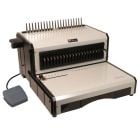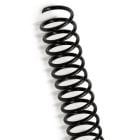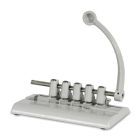Binding Your Business Manuals Inexpensively
If you are looking for an inexpensive method for binding your in-house materials such as manuals and safety books, here are some binding styles worth considering.
What Type?
For more informal business documents such as employee manuals and other similar in-house documents, you are probably looking for a binding style that values cost savings and durability over looks and charm. If that is the case, there are three tried and true binding methods that bear investigation on your part:
1.Plastic Comb binding. This is one of those binding styles that you have probably seen a thousand times and not ever known what it was called. As the name suggests, this method uses what look like plastic combs to keep your books together. The combs in question actually consist of long plastic spines with "teeth" that form circles and wrap around each other in order to hold the pages in place. This type of binding has many advantages. Binding machines that both punch the holes in your sheets and insert the combs into your documents are inexpensive, and the finished product is very rugged, holding the pages together through some fairly rough handling. The books also lie flat for easy hands-free reading making it a great choice for instruction manuals and the like.
2.Spiral Coil binding. Another method of binding you have seen without probably ever having known what it was called. When you think of spiral coil binding think if your wire notebooks from school, only with plastic wire instead of metal. This is an other method that is durable, relatively easy to complete, and inexpensive to get into, as far as purchasing a machine. One advantage that spiral coil has over plastic comb is that you can open these documents a full 180 degrees - in other words you can wrap the pages completely around, which is a very useful function.
3.Twin Loop Wire binding. Another method you've certainly see before, this style uses metal wire that is looped in twos up and down the spine of the document. This bind may be a little stronger than plastic comb, and is probably also a step up in the looks department. It is also every bit as functional as the previously mentioned methods.
How Is It Done?
When you have decided on the type of machine that you want to purchase, you will need to learn how to use it. Before that, however, you will want to make sure that you have taken care of come of the other items such as purchasing a heavier paper stock as needed so you won't be stuck without something to use for a cover. You will also want to make plans to print your pages in the numbers that you will need. If you don't have a printer that is up to the task, talk to your local copy shop to see that they can do for you.
When you have your pages numbered, collated, and everything is in order, place the pages in your binding punch in the numbers recommended for your machine, and punch the pages. Once the pages are punched, insert the spines, and your books are ready to go. You can even get two people in on the act -one punches while the other binds - to increase productivity.









